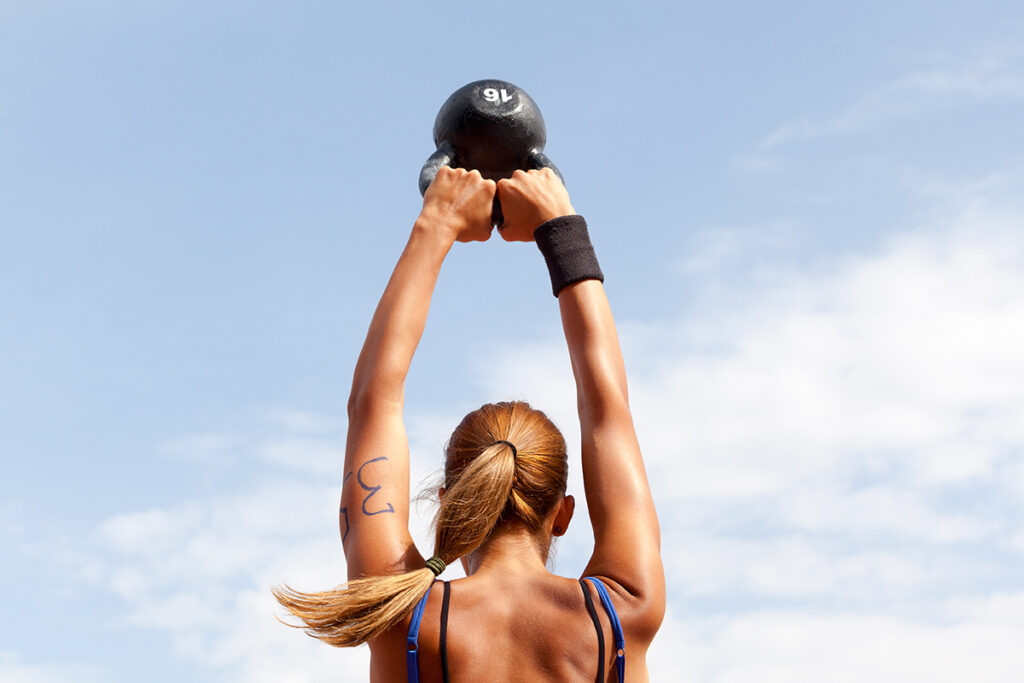An endomorph is one of the three body types. People with an endomorph body type have a slower metabolism, and find it more difficult to lose weight and keep it off.
Endomorphs achieve better results when they follow a workout and nutrition plan that takes their body type into account. With the right workout plan, you can burn more calories, change your body composition, and boost your metabolism.
To do this you need to incorporate different types of exercise into your routine. The endomorph workout plan consists of 3 parts.
Part 1
Burn Calories.
Cardiovascular exercise is an important part of any workout plan and should make up the bulk of an endomorph’s exercise routine.
Cardio workouts burn calories, and in conjunction with diet creates a bigger calorie deficit. It is a combination which leads to greater long-term weight loss.1 Therefore, cardiovascular exercise plays a key role in losing excess body weight, keeping the weight off after weight loss, and maintaining a healthy body weight.23
Furthermore, regular cardio improves cardiorespiratory fitness and has an incredible impact on health. Studies show that cardio reduces the risk of cardiovascular disease, diabetes, high blood pressure, and several cancers.4567 It also improves mental health, sleep, and energy levels.8910
People with an endomorph body type respond well to a workout plan comprised of a mix of high-intensity exercise and moderate-intensity cardio workouts.11 The oft-touted fat-burning zone that you’ll find on many cardio machines burns few calories and is an inefficient, time-intensive way of losing weight.
Striking a balance between a type of workout called high-intensity interval training (HIIT) and more moderate workouts is ideal for people with this body type, as it will test the heart, lungs, musculature and energy systems in different ways. A comprehensive approach will result in faster weight loss, superior fitness, and a wider spectrum of health benefits.1213
Moderate-Intensity Cardio
It’s an intensity that allows you to talk in short sentences. You should break into a sweat after at least 10 minutes and keep sweating for the entire hour.
If you haven’t exercised for a considerable period, start at about 60% of maximum heart rate (MHR). Slowly increase intensity and workout duration as your athletic ability improves.
High-Intensity Interval Training
HIIT substantially cuts down the amount of time you need to exercise because HIIT sessions are short and intense.
HIIT is a more advanced type of workout, should you should ease into it. If you are a beginner start with interval training, a less intense version of HIIT.
HIIT Advantages
HIIT also confers several benefits that lower intensity exercise either can’t or is unable to match to the same degree:
- Weight loss. Not only an efficient calorie burner, HIIT also increases the body’s fat burning ability, reduces appetite, and boosts the body’s sensitivity to insulin, thereby countering insulin resistance (a precursor to diabetes and linked to excess weight) and improving blood sugar control.1415161718
- Increased muscle mass. HIIT sessions can increase muscle mass, unlike endurance cardio.1920 Furthermore, research shows that HIIT is able to increase muscle mass while simultaneously reducing body fat.2122
- Increases metabolic rate. Moderate-intensity cardio workouts increase metabolism for several hours afterwards. However, HIIT can increase this “afterburn” to a greater degree and in less time.23
Check with your doctor before you start a new exercise program, especially if you haven’t exercised for a long time or are have any medical conditions.
The table below gives a rough guide of what the different exercise intensities feel like.
| Level/ Intensity | Heart Rate | Example | Breathing | Sweating |
|---|---|---|---|---|
| Low | < 65% MHR | Leisurely walk | Breathing normal, able to carry on full conversation | No |
| Moderate | 65-75%MHR | Brisk walk | Breathing deeper, can talk in short sentences | After 10 minutes |
| High | + 75% MHR | Running | Breathing fast and deep, talk in short spurts | After 3-5 minutes |
As you grow stronger, week by week, your workouts will feel easier. That means you have to make your workout harder to keep the intensity the same. To do this, you can incrementally increase the length of your workout, your pace, the resistance, or incline as you get more fit.
For example, if you started by walking briskly, you might might increase your pace or start a beginner run/walk plan to keep your workout challenging. This will burn more calories, help you to keep on losing weight, and increase your fitness levels.
Part 2
Build Muscle.
Equally, less muscle means you burn fewer calories and have a slower metabolism. This can happen when you lose weight. That’s because when you lose weight not all of it fat, some of it is muscle. Endomorphs can help prevent this by including strength training in their workout routine.
The best style of strength training for endomorphs is a full-body workout comprised of exercises that target multiple muscle groups at the same time (called compound exercises) like squats and lunges, in a fast-paced circuit with high repetitions and little time between sets.
This type of workout is great for endomorphs because it is a combination of cardio and strength training that maximizes calorie burning while increasing strength, compared to regular weight lifting that is more focused on maximising strength and building muscle.
Part 3
Increase NEAT.
NEAT activities are type you do as you go about your day such as standing, walking, taking the stairs, fidgeting, or doing household chores. NEAT has an impact on weight and health.
Metabolism. These types of activities may sound boring and insignificant. But they’re really not. They may be the key to why some people gain weight easily and others remain slender, despite living in the same weight-gain-encouraging environment (driving everywhere, sitting at a desk all day, snacking frequently). Research has shown that NEAT can differ hugely between people – varying by up to 700 calories per day.2425 Therefore, adding more of this type of movement throughout the day can help endomorphs boost metabolism and burn more calories, in order to help weight loss and resist weight gain.
Health. Increasing NEAT also has health benefits, and is linked with improving cardiovascular health and reducing the risk of chronic diseases. Research shows that higher levels of NEAT is associated with lower blood pressure, cholesterol, and waist circumference, as well as lower mortality from all causes and a lower risk of metabolic syndrome.262728
But get this. You can’t make up for NEAT with workouts. Studies suggest that NEAT and deliberate exercise are separate and independent factors that impact our health. In other words, exercise cannot cancel out the health damage caused by low levels of NEAT. Indeed, research suggests that people with low levels of NEAT may not even reap some of the cardiovascular and metabolic health benefits from exercise that they otherwise would.2930 Basically, NEAT is important for good health, as well as being an awesome calorie-burner.
How to Boost NEAT
Do you know how hard and long you’d have to exercise to burn 700 calories? NEAT is a big deal. The main problem with NEAT is that it is almost too easy. But if you can nail NEAT, you’ll find things will be a whole lot easier.
You can increase NEAT by making small changes, such as:
- Standing more often than sitting (e.g. more active lunch breaks, standing at your desk sometimes instead of sitting all the time)
- Changing posture/ position more often
- Taking frequent breaks from work or study to stretch or move around
- Taking the stairs instead of the elevator
- Walking short distances instead of driving or taking public transport, or parking the car a little further away
- Pacing while talking on the phone or watching TV
- Doing some household chores or gardening
To help with this, set an alarm to remind you to get up and move around. These simple actions can add up to a significant amount of calories burned over time, and also improve overall health and well-being.
Many of the above tips are also good practice to help avoid back pain, eye strain, and headaches from sitting too much in one position.
Overview
The Workout Plan.
HIIT by nature is intense, which means the body needs time to recover and repair. Therefore, leave at least one day between HIIT workouts. On days between HIIT you can perform moderate-intensity workouts, which are less taxing on the body.
Beginners. High-intensity interval training is very demanding and thus not suitable for beginners. Beginners should start with regular moderate-intensity cardiovascular exercise to build a solid fitness base.
To do this, start with 30 minutes moderate-intensity cardio workouts 3 times a week and slowly increase these to 5 a week. After about 6 weeks, start to incorporate some short bouts of slightly higher intensity exercise into 2 of your weekly workouts (interval training) to increase your fitness further, before doing HIIT (read more about how to get started with HIIT).
Rest. Allow for 1 – 2 rest days a week, during which you take a complete time out or perform low-intensity activities such as yoga, stretching or leisurely walking (active recovery).31
Exercise Timing for Endomorphs
If you can, do your cardio workouts at the same time each day. Research shows that a consistent workout time is associated with higher levels of exercise in people who successfully lose weight and keep it off.32
This consistency helps to make workouts a habit and a firm part of your daily routine – just like brushing your teeth. It’s an automatic process that you don’t even question and do without thinking. If you exercise in the morning, you’ll automatically get on your gear and go out for a brisk walk or run. If you exercise in the afternoon, you might head straight to the gym. The point is, making exercise part of your daily rhythm increases the likelihood of meeting – and crushing – your goals, not just now but in the long-term.
Mini-workouts. You can, if more convenient, break a longer moderate-intensity exercise session into several shorter ones. Simply leave the longer workouts for the weekend or less busy weekdays.
Studies suggest that shorter, more frequent workouts spaced throughout the day can as effective as one long workout of equal length.3334 You’re also less likely to run out of steam, enabling you to work out at higher intensity.
What’s the Best Time to Exercise?
The simple answer is that the best time of day you do your cardio is way less important than actually doing it, whenever that may be. Do it when you have the time and when you prefer. You might be a morning person or a night owl. Workouts at times that feel unnatural to you feel harder and are associated with greater levels of fatigue.35
Having said all that, if you can and it feels right, the best time to exercise first thing in the morning.36 You’re guaranteed to get your workout done. It’s out of the way, before distractions and excuses are able to take hold. Those who stick to their exercise routine long-term, are more likely to exercise in the morning.
Also, morning exercise may enhance weight loss by positively affecting eating habits and appetite, and is more likely to be done in a fasted state which may improve fat metabolism.373839 It’s also the perfect time to get energized and set for the day!
Lifestyle
The Long-Term.
Some endomorphs will require more exercise than others to maintain their weight loss. So you need to fine tune your workouts to suit your body and metabolism. How much you will need to exercise will also depend on your daily calorie intake.
How much exercise? Research suggests that many people who have lost more than 5% of their total body weight need to do at least 300 minutes of moderate-intensity activity (e.g. brisk walking) a week, to keep the weight off. Or about 150 minutes of vigorous activity (e.g. jogging) per week.
Lifestyle Activities
The best way to keep exercising long after you’ve lost weight is to find an activity that you enjoy doing and make it part of your lifestyle. But also one where you can measure your progress and work towards a goal.
For example, if you enjoy running you can work towards training for a 5K. This takes the focus off exercising just to lose weight, and onto achieving something else entirely. It gives you a real sense of physical and mental accomplishment and a success that goes way beyond weight loss. It’s empowering. And you’ll be hooked on it, not because you have to do it to lose weight or maintain weight loss, but because you love it and it makes you feel great.
The other advantage of training for a goal other than weight loss, is that you will achieve a higher level of fitness. This means that instead of brisk walking, for example, you can run or jog, burning at least twice as many calories per minute of exercise. In other words, it’s easier to prevent weight gain.
Choose any cardiovascular activity that you enjoy, be it swimming, cycling, tennis, or Nordic walking. And if you can join a club, even better! You’ll meet like-minded people and form new friendships, which will keep you motivated and give you more reasons to head out and exercise.









